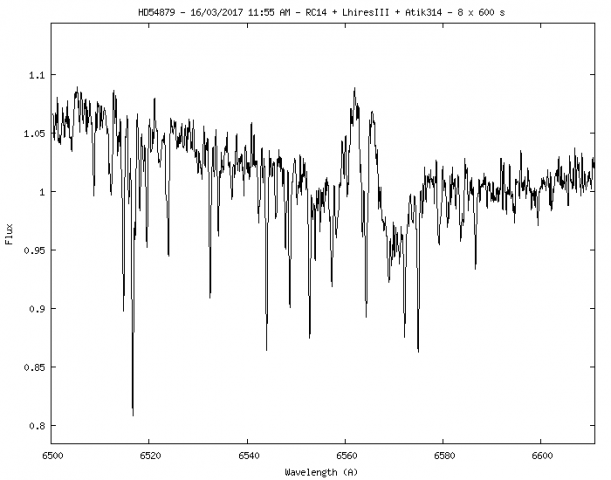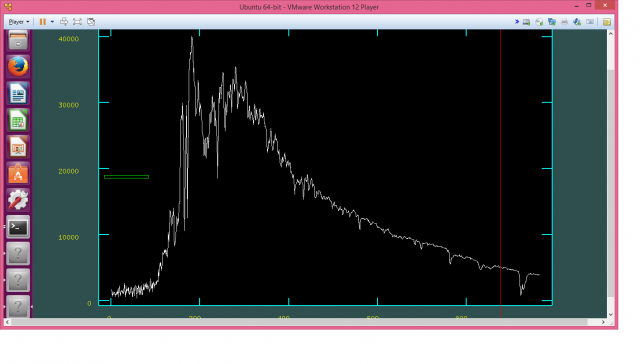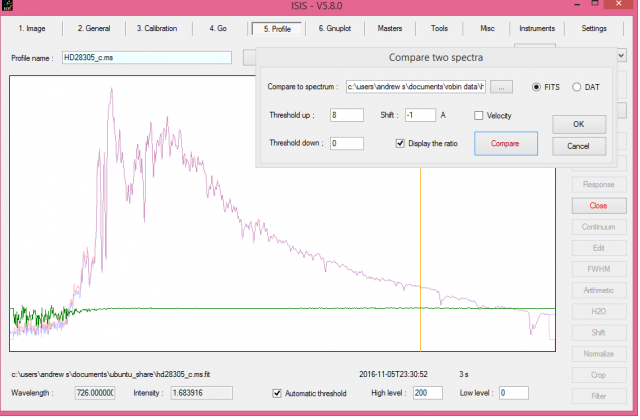› Forums › Spectroscopy › Data required
- This topic has 11 replies, 3 voices, and was last updated 8 years, 8 months ago by
 Dr Andrew Smith.
Dr Andrew Smith.
-
AuthorPosts
-
15 March 2017 at 11:23 am #573712
 Dr Andrew SmithParticipant
Dr Andrew SmithParticipantAs I mentioned in a previous post I am leaning IRAF. To this end I am working my way through its documentation to my final goal of reducing my fiber fed echelle spectra. Part of the learning curve is to reduce some long slit spectra. I used to have a LISA spectograph (donated to the BAA) but due to a computer crash I have lost my raw data ( I only backed up the final spectra – silly boy). If successful I also intend to do a cook book for armatures on IRAF spectral reduction.
I was wondering if some kind soul would let me have a set of data to process. It can be from any Shelyak long slit spectrgraph Lisa, LHires III or Aply (I would like to compare the result to ISIS). There is only one special addition to the normal set of data in that I would like two set of flats one with a few 100 ADU above bias and one with a few 1000 ADU above bias as IRAF uses these for bad pixel mapping. I would also line say 9 of each so I can try the different statistics in combining images.
In short I am looking for 9 each of
Any target star (preferably a Miles data base star or the cloudy sky will do!)
Calibration spectra (e.g. Ar Ne lamp)
Bias frames
Low ADU flats
High ADU flats
Dark Frames
I would also need to know the camera make and model.
I would be happy to send a USB stick to simplify the transfer. I would, of course, acknowledge the data provider in any documents I produce.
Thanks Andrew
15 March 2017 at 2:38 pm #578023 Robin LeadbeaterParticipant
Robin LeadbeaterParticipantHi Andrew,
Are the low and high ADU flats conventional imaging or spectroscopic flats? The reason I ask is my individual ALPY spectroscopic flats for example can typically range from a few hundred to a few tens of thousand ADU even within the flat due to the instrument response and lamp spectrum. If they are conventional imaging flats I could perhaps take a few of these to supplement my test data set of MILES stars posted on here for you to test.
Cheers
Robin
15 March 2017 at 5:04 pm #578024 Dr Andrew SmithParticipant
Dr Andrew SmithParticipantHi Robin, thanks for the offer of help. I would certainly need conventional spectroscopic flats. Looking at the documentation what it seems to be doing is comparing the values of the pixels between the two flats and their exposure to see which are obviously non linear. So I think either spectroscopic or normal imaging flats will do provided they differ in intensity pixel by pixel by a factor of 10 or so after bias subtraction and are not saturated.
Regards Andrew
15 March 2017 at 7:15 pm #578026 Robin LeadbeaterParticipant
Robin LeadbeaterParticipantHi Andrew,
Ok it would need to be observations going forward then. I can take two sets of flats in future for anything that might be suitable. Probably best not to depend on me short term though as I am back to the ALPY 200 supernova hunting setup currently which is not the most typical of applications.
Cheers
Robin
15 March 2017 at 7:21 pm #578027 Robin LeadbeaterParticipant
Robin LeadbeaterParticipantIt sounds like the prnu map which ISIS uses. For ISIS this is generated separately, illuminating the sensor disconnected from the instrument
http://www.astrosurf.com/buil/isis/eshel/reduction/echelle.htm
Cheers
Robin
16 March 2017 at 8:59 am #578030 Dr Andrew SmithParticipant
Dr Andrew SmithParticipantHi Robin, would you be willing to share a standard set with your normal spectral flats. The bad pixel removal is a final optional step and I am itching to get going?
IRAF uses different approaches to ISIS for both long-slit and echelle spectral extraction. It looks like the pros use both “dome” and sky/twilight flats rather than a prnu flat. As an example of the different approaches IRAF calibrates each “row” along the dispersion axis first, hence removing smile without a pixel by pixel translation, then does the extraction.
Regards Andrew
PS Anyone else willing to share some data with or without the two sets of spectral flats?
16 March 2017 at 12:24 pm #578031 Robin LeadbeaterParticipant
Robin LeadbeaterParticipantHi Andrew,
email sent
Robin
16 March 2017 at 12:48 pm #578032 Dr Andrew SmithParticipant
Dr Andrew SmithParticipantThanks for the data Robin and full marks for the analysis you did on the Aply.
Regards Andrew
17 March 2017 at 5:13 am #578034 Paul LuckasParticipant
Paul LuckasParticipantHi Andrew,
I’ve emailed you a link to a dropbox location with some zipped up Lhires2400 data of HD54879 (a current project). The target is on the faint side, so it may provide some worthy test material. Lots of Tellurics to play with too. 😉
Also in the folder are zipped archives of bias, darks and flats (but only one variety I’m afraid).
Looking forward to your results,
Paul
 17 March 2017 at 9:58 am #578036
17 March 2017 at 9:58 am #578036 Dr Andrew SmithParticipant
Dr Andrew SmithParticipantThank you both for sharing your data. They make a good contrasting pair. I will update you as (if) I make progress.
Interestingly Paul, I have yet to see a reference to tellurics in the documentation – not that I have looked for it.
Thanks again to both of you. I think I have enough data now and I even managed a clearish night two nights ago so have some new echelle data to ponder from a standard RV star and the yellow hypergiant Rho Cass.
Regards Andrew
18 March 2017 at 2:05 pm #578038 Dr Andrew SmithParticipant
Dr Andrew SmithParticipant Following the tutorial at http://www.twilightlandscapes.com/IRAFtutorial/ I have managed to extract a spectrum from Robins data on HD28305. I still have to calibrate it and there is no instrument response.
Following the tutorial at http://www.twilightlandscapes.com/IRAFtutorial/ I have managed to extract a spectrum from Robins data on HD28305. I still have to calibrate it and there is no instrument response.The tutorial uses some basic function rather the more complex ones so it has been good for learning what is going on.
The extracted profile would display in ISIS so moving between the packages should be quite possible.
The IRAF package is good at displaying image statistics and for these short exposures the bias and flat frame were not statistically different apart from the hot pixels so I just used the bias frames.
20 March 2017 at 6:43 pm #578041 Dr Andrew SmithParticipant
Dr Andrew SmithParticipantBy processing Robin’s HD28305 data in ISIS without either calibration or instrument correction I managed to directly compare the result I got from IRAF. It shows they are in effect (and as one would expect) identical apart from small differences at the short wavelength end where my decision not to use a dark in IRAF is amplified by the flat correction. (As I understand it the 1 pixel shift in ISIS is well known)
This give me confidence in using IRAF and to make the next steps in wavelength calibration and then on to echelle spectra.
Regards Andrew

-
AuthorPosts
- You must be logged in to reply to this topic.
